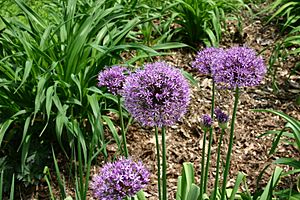Allium aflatunense facts for kids
Quick facts for kids Allium aflatunense |
|
|---|---|
 |
|
| Scientific classification |
Allium aflatunense is a type of beautiful flowering plant. It belongs to the amaryllis family, which also includes onions and garlic! This plant originally comes from Kazakhstan and Kyrgyzstan in Central Asia. People often grow it in gardens around the world because of its pretty purple flowers.
What Does Allium aflatunense Look Like?
Allium aflatunense is a plant that grows from a bulb, just like a tulip. It can grow quite tall, reaching about 36 in (0.9 m) (which is about 0.9 meters). It's a perennial plant, meaning it lives for more than two years.
This plant has long, flat leaves that look like straps and grow from the base of the plant. Its flower stems, called scapes, are hollow and have slight ridges. At the top of these stems, you'll find a round, dense cluster of flowers called an umbel. This flower head is about 10 cm (4 in) (about 4 inches) wide and is made up of many star-shaped, purplish-pink flowers.
Allium aflatunense usually blooms in May and June. Its seeds are ready to be collected in August. You can often buy this plant as a bulb to plant in your own garden.
Sometimes, A. aflatunense can be mistaken for another similar plant called A. hollandicum.
How to Grow Allium aflatunense
Allium aflatunense is a strong plant that can handle cold weather. It grows well in areas known as USDA zones 4–8. This means it can survive winters where temperatures drop quite low.
Gardeners often use Allium aflatunense as a cut flower in bouquets and arrangements because of its striking appearance. While it prefers soil that is slightly alkaline (meaning it's not too acidic), it can still grow in poor soil conditions. It also does best when it gets lots of sunshine, but it can tolerate some shade.
See also
 In Spanish: Allium aflatunense para niños
In Spanish: Allium aflatunense para niños

